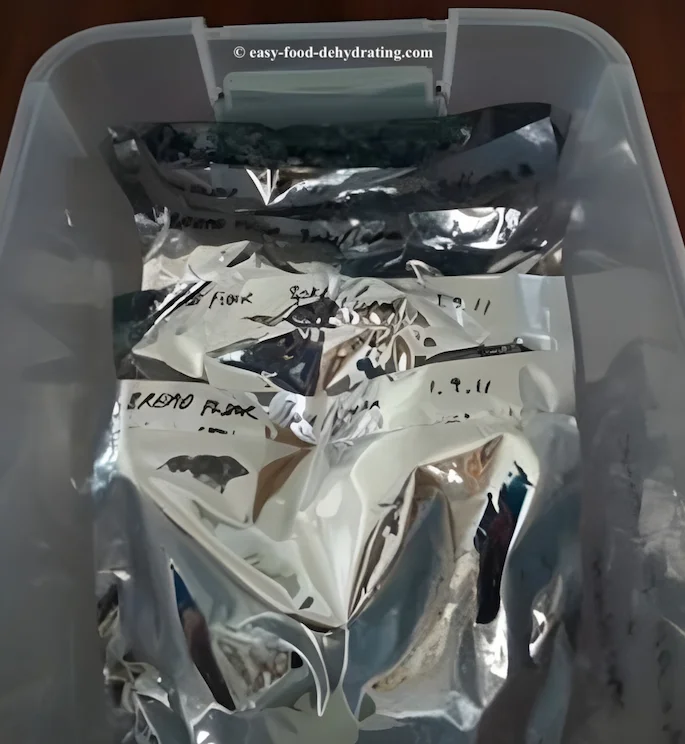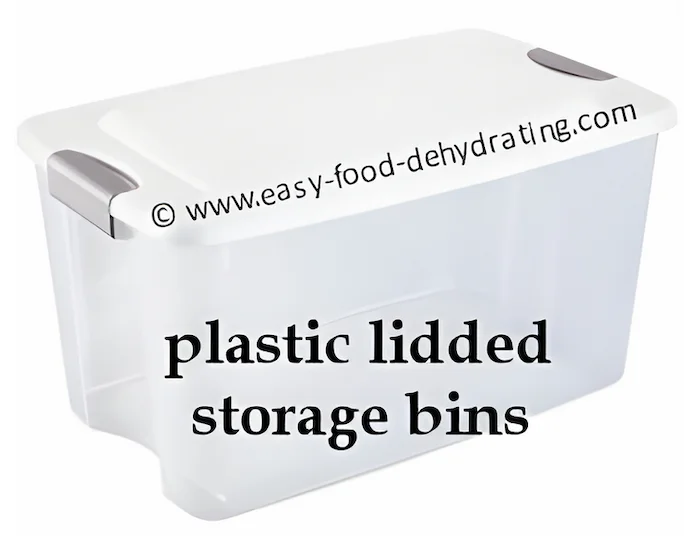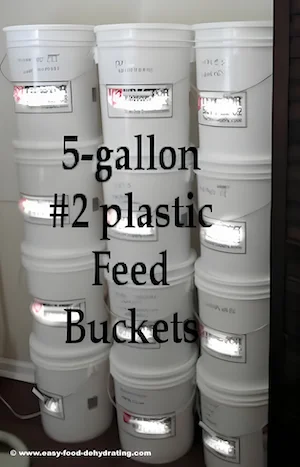What We Mean by “Dehydrate”
Here at Easy Food Dehydrating, “dehydrate” always means using an electric food dehydrator — the easy, reliable way to dry food at home.
- Home
- How to Store Dehydrated Food for Long-Term Freshness
- Storing Rice and Flour
Storing Rice and Flour
for Long-Term Dry Food Safety

Storing rice and flour correctly means your pantry staples last longer, stay fresher, and remain bug-free. These simple methods not only protect your food from moisture and air but also give you peace of mind that your essentials will be safe and ready when you need them.
✅ Quick Answer: How do you store rice and flour long-term?
The best way to store rice and flour is in vacuum-sealed Mylar bags with oxygen absorbers, placed inside airtight food-grade buckets. Keep them in a cool, dark, and dry place to prevent spoilage, moisture, and insect damage.
Whether you’re preparing for emergencies or simply buying in bulk, the right tools—like oxygen absorbers, Mylar bags, and airtight buckets—make all the difference. Let’s walk through the smartest ways to keep rice and flour fresh for months or even years.

In the photo above, I've got flour stored in Mylar bags, and then I put them in the large plastic-lidded bins when I need to store these items for the long term.
Even though the flour, rice, and beans are "dry" to begin with, if you're interested in storing these items safely, then follow the vacuuming-sealing method used when storing your dehydrated foods.
We're all about protecting our foods from the three enemies:
- Light
- Air
- Moisture
I still strongly advise you to add an oxygen absorber into the individual vacuum-sealer bags before vacuum-sealing the air out, as they keep mold growth at bay.
Adding the oxygen absorber will also protect your flour and rice from insect damage, too.
Why Oxygen Absorbers Are Essential for Rice and Flour
Coming up are the different sizes of oxygen absorbers!
Oxygen absorber sizes range in sizes from 50cc, 100cc, 300cc to a whopping 2000cc!
Why is there such a size range? When using smaller Mason jars, a 50cc oxygen absorber is ideal. For a larger quart-size Mason jar, then a 100cc size will be fine.
Best Oxygen Absorber Sizes (and Where to Buy)
When to Use 50cc Oxygen Absorbers
50cc are perfect for small jars and containers. Ideal for keeping spices and smaller dried foods fresh.
Best Uses for 100cc Oxygen Absorbers
100cc are great for quart-sized jars and vacuum-sealer bags. The most versatile size for everyday use.
- PackFreshUSA Oxygen Absorbers
- 200-Pack
- Food-Grade, Non-Toxic
- Oxy-Sorb Oxygen Absorbers
- 100-Pack
- Long-Term Food Storage Freshness Protection
- Oxy-Sorb Oxygen Absorbers
- Bags of 20 (60 Count total)
- Super Effective for Dried Goods
- Oxy-Sorb Oxygen Absorbers
- Pack of 10
- I use these for airtight bins and buckets
As an Amazon Associate, I earn from qualifying purchases — this does not affect the price you pay. Read full disclosure.
A NOTE HERE about DESICCANT PACKETS
Use them in conjunction with Oxygen Absorbers.
Here's How and Why...
Using Mason Jars for Storing Rice and Flour
If you live in a humid area and are thinking of storing rice and flour to keep the dry goods dry, use Mason jars for storing rice and flour, or in specialized canisters with an air-tight seal.
Mason jars are ideal for those who use rice on a weekly basis. Mason jars are too small for flour, Of course, you can use flour canisters or bins which are available at specialty kitchen goods stores as mentioned above.
You can add an oxygen absorber in the Mason jar along with the rice - the primary job of an oxygen absorber "is" to absorb oxygen, as the name implies.
I wouldn't bother adding an oxygen absorber into the big flour bins IF you are in and out of the flour bin on a regular basis.
IF you're not in the flour bin more than once or twice a month, then by all means pop in a massive 2000cc oxygen absorber and put the lid on it. Doing so will help keep moisture and bugs at bay.
Bins vs. Buckets: Which Works Best for Long-Term Storage?
This is one of the bins I showed at the top of the page, with its
lid. Its purpose is to store vacuum-packed and sealed Mylar bags that
contain our dehydrated foods - not massive bins full of loose dehydrated
foods!
These bins ARE NOT airtight due to their handles, so don't bother adding an oxygen absorber inside it.
You can get these plastic lidded bins at Walmart, Home Depot, or Lowe's or - yes, you guessed it - from Amazon online. Amazon has everything. You know that.
Storing Rice and Flour in Air-tight Buckets - Suitable for Storing Salt and Sugar Too
If you're looking for air-tight storage, use feed buckets with lids.
Use 2000cc oxygen absorbers in buckets; they're perfect for this as they really ARE air-tight.
Check out these buckets at a 'Tractor Supply' website or (of course!) on Amazon!
We also have a similar post that mentions how to store salt and sugar.
Also, read all about Storing Dehydrated Food.
Best Places to Keep Your Rice and Flour Safe
Great question! Look, I know it's hard to find space in closets, but they are ideal. Why? They are dark so that keeps direct light off your dry goods. Both the bins and buckets are great for stacking, too.
Check out this "how to create storage out of thin air" post where I go into detail on how to add storage on a blank wall - if you've run out of closets which I suspect happens 99% of the time!
How to Safely Stack Bins and Buckets
Put the heavier goods at the bottom of the pile so they're not "top heavy." They hurt when they fall on you. Ask me know I know. Ouch.
You can safely stack around 5 plastic-lidded bins and about 4 buckets in a stack. I could only manage 4 buckets because I'm only a tad over five feet tall and it's too hard for me to reach them!
Again, keep the heavier buckets on the bottom.
These bins and buckets really don't take up too much room in the closet. I look at it this way: you can eat dehydrated food and beans, but you can't eat clothes.
Other folks like to store their bins and buckets filled with dehydrated goodies in their garage, but please beware of extreme heat and extreme cool temperatures. And BUGS.
Rice & Flour Storage FAQs You Didn’t Know You Needed
What’s the safest way to store rice and flour long-term?
What’s the safest way to store rice and flour long-term?
Use vacuum-sealed Mylar bags with the right size oxygen absorbers, then place them inside airtight food-grade buckets. Store in a cool, dark, and dry location.
How long can flour and rice last in storage?
How long can flour and rice last in storage?
White rice can last up to 25–30 years when sealed properly, while flour typically lasts 1–2 years in Mylar bags with oxygen absorbers. Whole wheat flour has more oils and won’t last as long—usually 6–12 months.
Can I store rice and flour in Mason jars?
Can I store rice and flour in Mason jars?
Yes. Mason jars are excellent for smaller quantities, especially rice. Use 50cc–100cc oxygen absorbers for freshness. Flour is bulkier, so jars are best for short- to medium-term storage.
Should I use desiccant packets too?
Should I use desiccant packets too?
Yes. Desiccant packets work alongside oxygen absorbers to control both moisture and oxygen, giving your storage double protection.
Where should I keep my filled bins and buckets?
Where should I keep my filled bins and buckets?
The best place is a closet or pantry away from light, heat, and humidity. Avoid garages unless they’re temperature-controlled.
What size oxygen absorber do I need for 5-gallon buckets?
What size oxygen absorber do I need for 5-gallon buckets?
Use 2000cc oxygen absorbers in 5-gallon airtight buckets for storing rice, flour, beans, or sugar. Use a 200-300g desiccant packet for larger containers.
Thanks for stopping by to learn how to safely store rice and flour (and other dry goods too!). With just a few tools—like oxygen absorbers, Mylar bags, and airtight containers—you can keep your pantry staples fresh, safe, and bug-free.
And before you go, don’t forget to grab your free 5 Dried Food Recipes You’ll Actually Love PDF (below), featuring tasty favorites like carrot soup, minestrone, split pea soup, spicy beef jerky, and banana cinnamon rolls.
Get 5 Dried Food Recipes You'll Actually Love
Here's where you can get your copy of our all new
5 Dried Food Recipes (That Actually Taste Great)
They're my all-time favorite easy dried food meals!
Get it here right now.
For Free!
Before You Go...
If you enjoyed this page, tap the ❤️ in the lower right-hand corner.
It saves this page to your Grow bookmarks so you can find it again later.
You’ll also see quick share buttons to copy the link, post to Facebook,
or save it straight to Pinterest.























